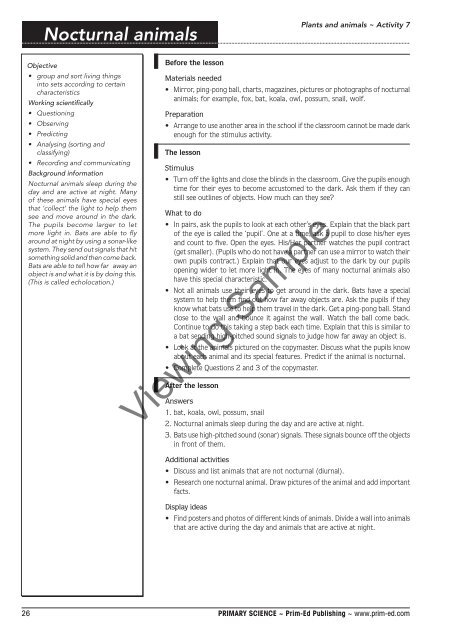PR-0552UK Primary Science - Book 2
You also want an ePaper? Increase the reach of your titles
YUMPU automatically turns print PDFs into web optimized ePapers that Google loves.
Nocturnal animals<br />
Plants and animals ~ Activity 7<br />
Objective<br />
• group and sort living things<br />
into sets according to certain<br />
characteristics<br />
Working scientifically<br />
• Questioning<br />
• Observing<br />
• Predicting<br />
• Analysing (sorting and<br />
classifying)<br />
• Recording and communicating<br />
Background information<br />
Nocturnal animals sleep during the<br />
day and are active at night. Many<br />
of these animals have special eyes<br />
that ‘collect’ the light to help them<br />
see and move around in the dark.<br />
The pupils become larger to let<br />
more light in. Bats are able to fly<br />
around at night by using a sonar-like<br />
system. They send out signals that hit<br />
something solid and then come back.<br />
Bats are able to tell how far away an<br />
object is and what it is by doing this.<br />
(This is called echolocation.)<br />
Before the lesson<br />
Materials needed<br />
• Mirror, ping-pong ball, charts, magazines, pictures or photographs of nocturnal<br />
animals; for example, fox, bat, koala, owl, possum, snail, wolf.<br />
Preparation<br />
• Arrange to use another area in the school if the classroom cannot be made dark<br />
enough for the stimulus activity.<br />
The lesson<br />
Stimulus<br />
• Turn off the lights and close the blinds in the classroom. Give the pupils enough<br />
time for their eyes to become accustomed to the dark. Ask them if they can<br />
still see outlines of objects. How much can they see?<br />
What to do<br />
• In pairs, ask the pupils to look at each other’s eyes. Explain that the black part<br />
of the eye is called the ‘pupil’. One at a time, ask a pupil to close his/her eyes<br />
and count to five. Open the eyes. His/Her partner watches the pupil contract<br />
(get smaller). (Pupils who do not have a partner can use a mirror to watch their<br />
own pupils contract.) Explain that our eyes adjust to the dark by our pupils<br />
opening wider to let more light in. The eyes of many nocturnal animals also<br />
have this special characteristic.<br />
• Not all animals use their eyes to get around in the dark. Bats have a special<br />
system to help them find out how far away objects are. Ask the pupils if they<br />
know what bats use to help them travel in the dark. Get a ping-pong ball. Stand<br />
close to the wall and bounce it against the wall. Watch the ball come back.<br />
Continue to do this taking a step back each time. Explain that this is similar to<br />
a bat sending high-pitched sound signals to judge how far away an object is.<br />
• Look at the animals pictured on the copymaster. Discuss what the pupils know<br />
about each animal and its special features. Predict if the animal is nocturnal.<br />
• Complete Questions 2 and 3 of the copymaster.<br />
After the lesson<br />
Answers<br />
1. bat, koala, owl, possum, snail<br />
2. Nocturnal animals sleep during the day and are active at night.<br />
3. Bats use high-pitched sound (sonar) signals. These signals bounce off the objects<br />
in front of them.<br />
Viewing Sample<br />
Additional activities<br />
• Discuss and list animals that are not nocturnal (diurnal).<br />
• Research one nocturnal animal. Draw pictures of the animal and add important<br />
facts.<br />
Display ideas<br />
• Find posters and photos of different kinds of animals. Divide a wall into animals<br />
that are active during the day and animals that are active at night.<br />
26 <strong>PR</strong>IMARY SCIENCE ~ Prim-Ed Publishing ~ www.prim-ed.com


















